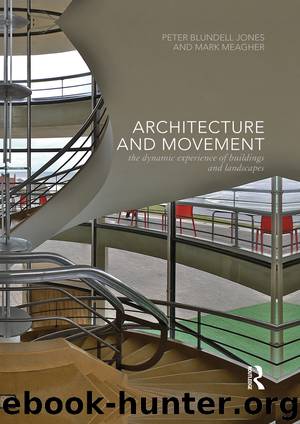Architecture and Movement by Unknown

Author:Unknown
Language: eng
Format: epub
ISBN: 9781317655282
Publisher: Taylor & Francis (CAM)
Figure 2.8.3 Exhibition Road, bus and milk float move slowly through a space also used by people
Source: Photograph by Ben Hamilton-Baillie
The widespread problems associated with traffic and the built and natural environment have been well documented. The Save Our Streets campaign of 20084 reflected the extent to which traffic impact dominates local concerns in almost every neighbourhood and community. Take a walk in almost any urban, suburban or rural settlement, and the immediate experience is dominated and framed, not by the architecture or landscape, but by the signs, signals, markings, bollards, barriers and linear asphalt of the traffic world. Pedestrian movement flows are constrained to limited peripheral space and occasional formal crossing points. As David Engwicht has pointed out in Mental Speed Bumps,5 drivers adopt speeds depending on the degree of psychological retreat of human activity from streets. This establishes a vicious circle, as people withdraw from trafficked space, generating higher speeds and further withdrawal. Reversing this cycle is critical to establishing a less damaging relationship between traffic and public space.
The need to re-evaluate the balance between traffic and urban quality reflects much more than concern for aesthetic sensibilities. There is an urgent economic imperative. With the dramatic changes in trading and retailing prompted by out-of-town superstores and the Internet, the purpose of many of our streets and public spaces has fundamentally changed. No longer necessary for the functional necessities of trade and distribution of goods and services, town centres have become places that only exist to fulfil higher-order expectations for human interaction and enjoyment. It is no longer possible for towns to exist solely as functional frames for market activity; they have to be able to attract human presence through intrinsic qualities. This change is prompting the search for new ways to reconcile traffic movement with the future purpose of urban space.
Development of new techniques and principles for integrating traffic movement into civic life owes much to pioneering work in Denmark, France, Germany, Sweden and especially the Netherlands, from the late 1970s onwards. Engineers such as Joost Váhl began to explore new models for residential streets, leading to the concept of the woonerf in places such as Delft, Gouda and Culemburg. In the north of the Netherlands, the late Hans Monderman introduced a remarkable palette of measures for streets and intersections in his position as head of road safety for his native Friesland. Starting with the aim of quieter village centres, Monderman developed a range of techniques that extended traffic engineering to encompass all aspects of landscape, history, geology and architecture. He sought to re-integrate the driver into the normal civilities of the pedestrian world, and, to his surprise, he found that the alterations he made appeared to improve both the safety and efficiency of traffic movement, even when applied to busier urban junctions and high streets.
At the core of Monderman’s alterations lie a number of principles that apply an under -standing of the influence of context and place to the experience of movement among drivers and pedestrians. He
Download
This site does not store any files on its server. We only index and link to content provided by other sites. Please contact the content providers to delete copyright contents if any and email us, we'll remove relevant links or contents immediately.
Kathy Andrews Collection by Kathy Andrews(10594)
The remains of the day by Kazuo Ishiguro(7603)
Spare by Prince Harry The Duke of Sussex(4247)
Paper Towns by Green John(4193)
The Body: A Guide for Occupants by Bill Bryson(3863)
Be in a Treehouse by Pete Nelson(3248)
Harry Potter and the Goblet Of Fire by J.K. Rowling(3126)
Goodbye Paradise(3007)
Never by Ken Follett(2942)
Into Thin Air by Jon Krakauer(2726)
The Remains of the Day by Kazuo Ishiguro(2637)
The Genius of Japanese Carpentry by Azby Brown(2630)
The Cellar by Natasha Preston(2622)
Drawing Shortcuts: Developing Quick Drawing Skills Using Today's Technology by Leggitt Jim(2546)
120 Days of Sodom by Marquis de Sade(2460)
Architecture 101 by Nicole Bridge(2367)
Machine Learning at Scale with H2O by Gregory Keys | David Whiting(2353)
The Man Who Died Twice by Richard Osman(2327)
Industrial Automation from Scratch: A hands-on guide to using sensors, actuators, PLCs, HMIs, and SCADA to automate industrial processes by Olushola Akande(2267)
